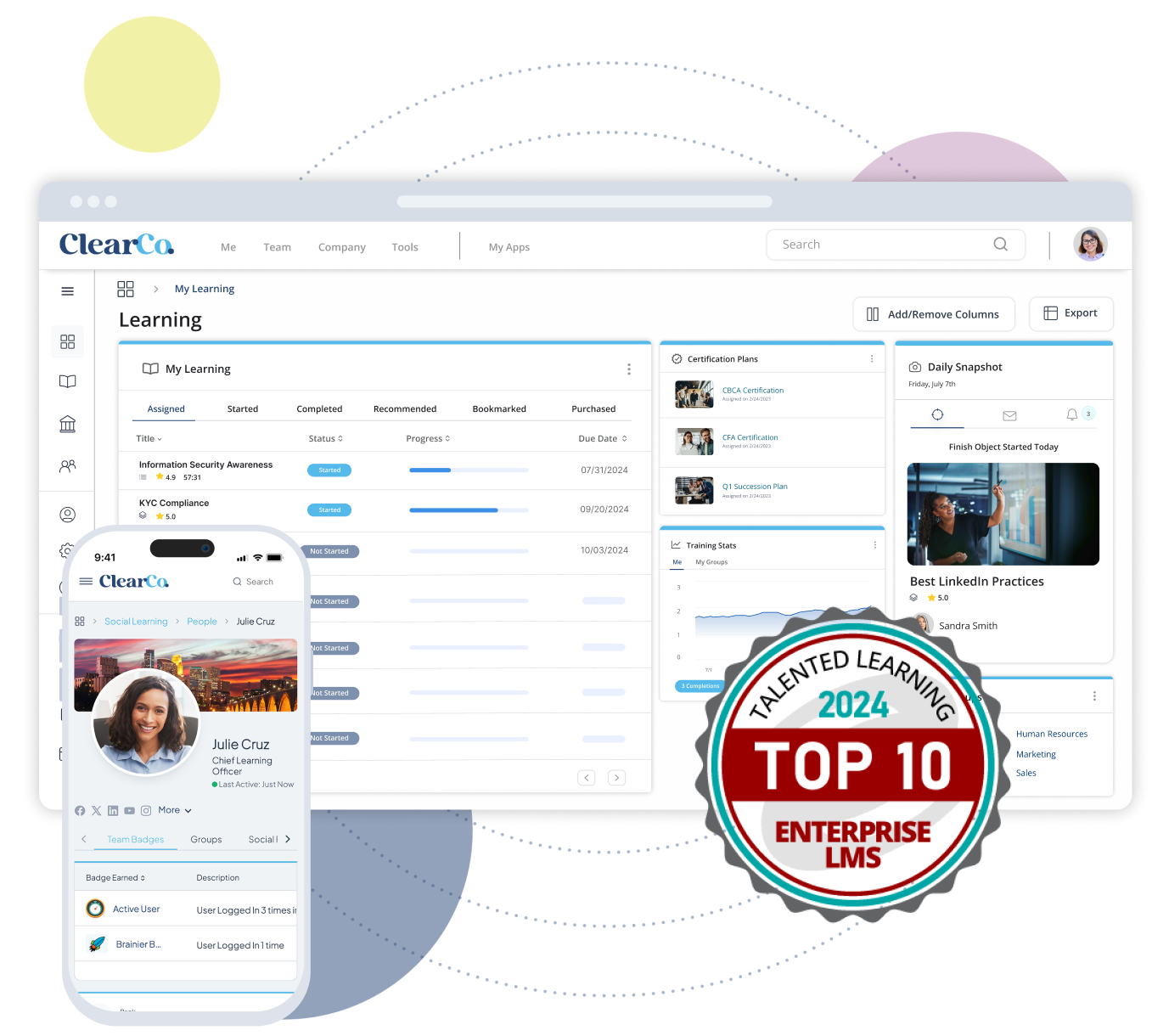Investments in employee training initiatives are on the rise, with spending increasing to an average of $1,400 per person over the last few years. That’s for good reason as companies work to close skill gaps impacting the bottom line and hire — and keep — top talent in a competitive market.
But how do you know if those investments are paying off? You need to measure the ROI of your employee learning and development (L&D) expenses.
Why Is It Important To Calculate Training ROI?
Return on investment (ROI) tells you what you gained from your expense. In this case, ROI is the business impact of L&D spending on an organization. That’s important because it gives you concrete evidence of whether or not training programs are actually worth the time and money spent creating and executing them.
Calculating ROI shows you if your training programs are on the right track or if it’s time to try a different approach. It helps you quickly identify which training investments are paying off so you can lean into what’s working and adjust what isn’t.
A clear ROI calculation is also essential for securing future L&D budgets. When you can present leadership with hard data showing how training directly contributes to business goals — like increased sales, improved productivity, or lower employee turnover — you build a strong case for continued or even increased investment. Using a data-driven approach helps leadership see training not as an expensive perk but as a strategic necessity that drives the business forward.
Tracking employee training ROI also improves the training itself. The process of gathering data forces you to define what success looks like for each program. With that clarity, you can design more effective, targeted training materials that address specific skill gaps and align with organizational objectives. It creates a cycle of continuous improvement, where you constantly refine your L&D strategy based on what works — according to the data.
How To Calculate the ROI of Training Initiatives
Calculating the ROI of learning programs might seem complex, especially if you weren’t a math whiz, but it can be broken down into a clear, step-by-step process. Following these steps will help you connect your L&D efforts to real business outcomes and prove the importance of employee training.
1. Define Clear Training Objectives & KPIs
Before you can measure success, you have to know what success looks like. Start by setting specific goals for your training program. What do you want employees to be able to do after completing it? These objectives should be tied to important training KPIs (key performance indicators) — the specific metrics you'll use to track progress.
For example, if you're launching a sales training program, your objective might be to improve closing techniques, and a corresponding KPI could be a 10% increase in the sales conversion rate. If you need to create training for a new piece of equipment to be used for both current employees and new hires, your goal might be to have at least 90% of employees reach 100% competency within two weeks. The corresponding KPI could measure proficiency rates at different intervals:
- Prior to starting training
- At critical points during training programs
- Immediately after completing training
- Long-term proficiency (+30 days or more after training is completed)
2. Track All Training Costs
To calculate your return, you first need to know your total investment. This means tracking every expense associated with the training program. Don’t just consider the obvious costs like course fees or software licenses. Be sure to account for all expenses, including:
- Instructors' salaries
- Rental fees for off-site or in-person sessions
- Employee wages for the time spent in training
- Development costs for creating materials
- Any administrative overhead
A complete picture of your costs is essential for an accurate ROI calculation.
3. Measure Learning Outcomes
To see if your training is truly fostering skill development and growth, it’s important to go beyond just handing out certificates. This is where a learning management system (LMS) becomes an invaluable tool. An LMS allows you to create, deliver, and track all aspects of training in one place. It enables you to monitor post-training assessments, quizzes, and even hands-on skill demonstrations to gauge exactly what employees have learned.
In addition to testing knowledge, an LMS collects data on employee participation, completion rates, and progress over time. You can also use built-in surveys to measure employee engagement and gather detailed feedback on each training module. This step helps you understand if knowledge was successfully transferred and how actively employees are involved in learning. That makes it easier to connect training activities with on-the-job performance.
4. Measure Business Impact
This is where you connect the training to tangible business results. Look at the KPIs you defined in the first step and measure the change after the training program is completed.
Did it lead to increased productivity? Did customer satisfaction scores go up? Did employee turnover decrease? The key is to isolate the impact of the training as much as possible.
For instance, you could compare the overall performance of a team that received training against a control group that did not. You could also look at whether the training was effective on an individual level for even more insight. If it improved just a few employees’ performance, your program may need some tweaks — and those few employees could be high performers or high-potential talent.
5. Calculate ROI
Once you have your total costs and the financial value of your business impact, you can calculate the ROI. You’ll end up with a clear percentage representing your return. Ideally, that percentage should exceed 100% — anything less means you’re losing money on your investment.
To use the ROI formula, first find the Net Program Benefits by subtracting the program costs from the total financial benefits you measured. Then, divide that number by the program costs and multiply by 100 to get a percentage.
 For example, if your training program cost $15,000 and resulted in a $50,000 increase in productivity and sales, your net benefit is $35,000. Your ROI would be ($35,000 ÷ $15,000) x 100 = 233%.
For example, if your training program cost $15,000 and resulted in a $50,000 increase in productivity and sales, your net benefit is $35,000. Your ROI would be ($35,000 ÷ $15,000) x 100 = 233%.
6. Continuously Evaluate & Adjust
Effective training programs evolve over time. Regularly review the data you’ve collected — learning outcomes, business impact, and ROI metrics — to identify trends and areas for improvement. This gives you opportunities to fix what’s broken and build on what’s already working. For example, if a particular training module consistently delivers strong results, you might consider expanding it to other teams or departments.
On the other hand, if certain programs aren’t having the intended impact, dig deeper to understand why. Is the content outdated? Are employees struggling to apply what they’ve learned? Use these insights to make targeted adjustments.
You can also stay proactive by aligning your training initiatives with changing business goals and industry trends. You’ll keep L&D programs relevant and continue to drive impact.
How To Improve ROI of Learning & Development Programs
Once you start measuring the ROI of your training, you can begin to improve it. Boosting the return on your L&D investment comes down to smart alignment, cost control, and fostering a culture that values continuous learning and growth.
1. Align L&D With Business Objectives
Connect every training program to a specific business goal. Work with department leaders to identify critical skill gaps that affect the bottom line. When training solves a real business problem, its value becomes much easier to prove.
2. Optimize Cost Efficiency
Deliver quality training more affordably. This could mean using blended learning models that mix online and in-person sessions, swapping long courses for microlearning, or creating reusable content for new hires. Lowering costs without sacrificing quality directly increases your ROI.
3. Measure Beyond Completion Rates
Fishing a course doesn’t always mean employees picked up a new skill. Focus on performance metrics instead. Track metrics like increased employee engagement and KPI improvements after training to get a true picture of training effectiveness.
4. Encourage Manager & Leadership Involvement
When your managers champion training, their teams are more engaged. Encourage leaders to discuss career development goals with their reports and create opportunities for employees to apply new skills. This reinforces that learning is a critical company value.
5. Leverage Learning Technology
A modern LMS that measures ROI does far more than just host courses. It automates tracking, personalizes learning paths, and collects detailed analytics on participation and performance. With an LMS designed to measure ROI, you can clearly see how training translates into business impact, making your L&D efforts more efficient, effective, and easier to justify.
The right technology gives you data-driven insights you can use to continuously improve your learning programs and boost your return.
See How ClearCompany’s Employee Development Software Drives Measurable Results
ClearCompany Learning makes it easy to create, manage, and measure effective training programs. Track skills, link learning with performance, and prove the impact of your L&D investment — all in one place.
Ready to maximize your training ROI? Schedule a demo with a ClearCompany expert today.


